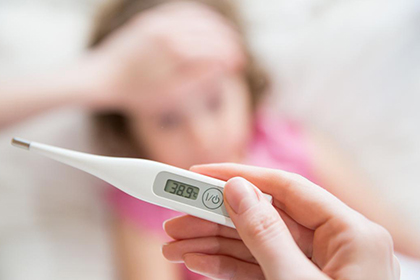Fever

Q. When should I be concerned about fever?
A. Fever is defined as body temperature above 38 degree C (100.4 degree F). One can check body temperature in mouth, on forehead, in axilla, in ear or rectally. Axillary temperature measurement may not be the most accurate but is easy and is most widely used site.
Q. What causes fever?
A. Infection is the most common cause of fever in children. Viral respiratory infection is the commonest cause of fever in young children. Some of the medicines also can cause fever. Fever is not always harmful.
In small infants over clothing can cause mild fever.
Q. Checking temperature:
A. When the temperature is checked in axilla one must first wipe the sweat and then put thermometer for two minutes or in case of digital thermometer till one hears the beep. The forehead strip method is not accurate. Rectal temperature measurement is not easy. If one is checking rectal temperature, it is advisable to lubricate the bulb of the thermometer with petroleum jelly (Vaseline) and then insert half an inch into the anus. Ear temperature record (Thermoscan) though is very quick, as it takes two seconds to record but can be misleading if the device is not calibrated and is not put properly.
Q. When should I treat fever?
A. A low grade fever especially in an otherwise cheerful child doesn’t need to be treated. Fever may help fighting the infection. Rather than treating the fever, it is important to know when to consult a pediatrician and those conditions are mentioned above.
Q. When should I consult a Pediatrician?
A. Following are situations where a child with fever should be taken to the pediatrician:
• Fever in infants less than three months of age
• Fever above 39 degree C in children aged less than three years, especially if not responding to Paracetamol
• Fever above 40 degree C at any age
• Fever of more than seven days duration
• Fever with refusal to feed or child looking very sick
• Fever with irritability or drowsiness
• Fever with neck pain, severe headache, severe sore throat or severe ear pain
• Fever with breathing problem
• Fever with bruises or bleeding
• Fever in children who have underlying chronic illness
• Fever in children who are on immune-suppressive medicines
• Fever in children who have had Febrile convulsion
• Fever lasting for more than three days after a vaccination
In all these conditions it is important to evaluate the child and treat the fever and its cause. Fever should also be treated even if above mentioned causes are not suspected but the child is uncomfortable.
Q. How do I treat Fever?
A. It is advisable to dress the child light or uncover the overclothed child. The room should be kept cool and well ventilated. Paracetamol is the drug of choice to bring the fever down. Your Pediatrician will advise you the doses based on child’s weight. Paracetamol can be given four hourly based on the need. It is not advisable to use strong medicines to bring the fever down especially when we don’t know the cause of fever.
If high fever is not responding to Paracetamol, sponging with tap water or luke warm eater may be advised. It should be done all over the body especially in axilla, groin and abdomen.
It is also advisable to keep hydrating the child. That helps controlling the body temperature. If the child is not feeling hungry, he shouldn’t be forced fed but we should focus on giving plenty of oral liquids. Small quantities of liquids can be given frequently.
Children who have fever may be encouraged to take proper rest.
